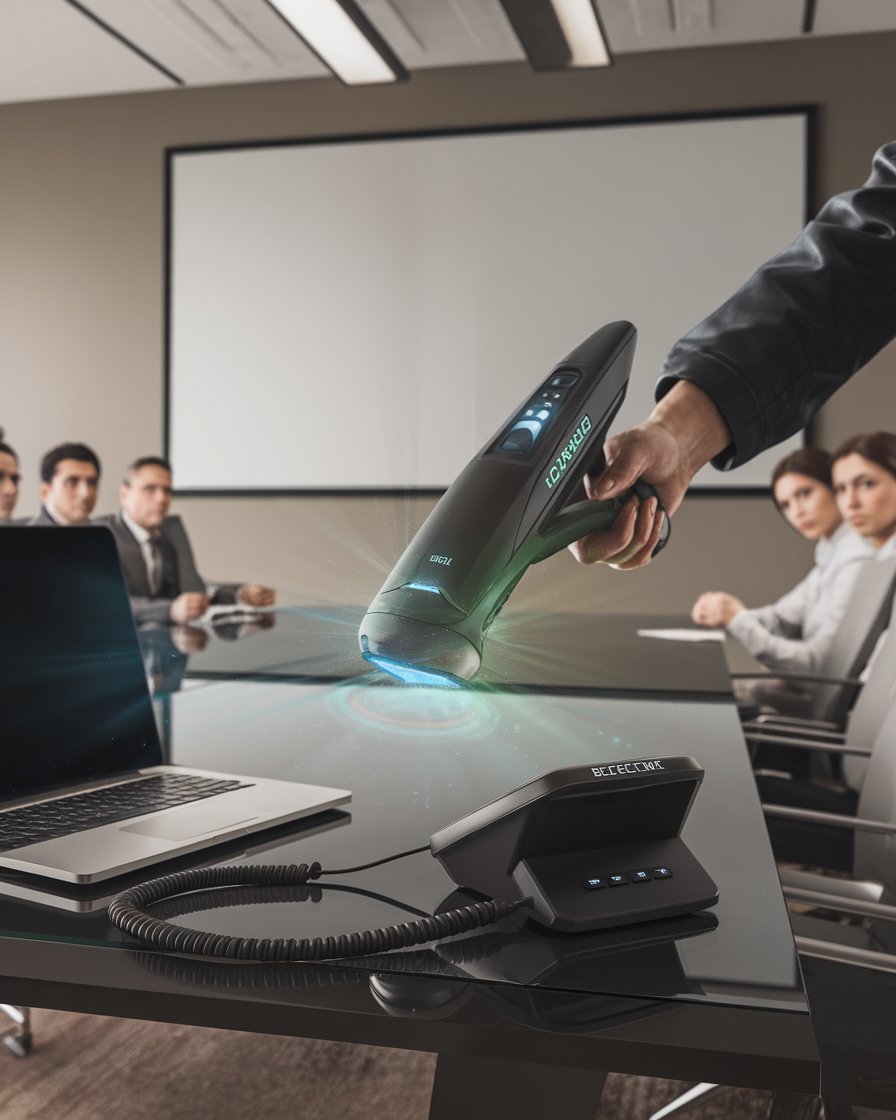- Anti Spy RF Signal Scanner
- Wireless Rechargeable
- Home丨Office丨Travel丨Hotel
- 6 Levels Sensitivity 4 Modes, 34H Work
Introduction
In today’s office environments, privacy is a top concern, and detecting hidden surveillance devices has become crucial. Whether you’re worried about someone eavesdropping on sensitive meetings or capturing confidential information, taking steps to detect bugs is essential. Hidden cameras, listening devices, and other eavesdropping equipment can be difficult to spot, especially if they are integrated into everyday office supplies. Conducting regular bug sweeps, either on your own or through professional services, helps ensure your office remains secure. Using tools like RF detectors, you can detect bugs and safeguard your conversations from unwanted attention.
Bug detection isn’t limited to just finding obvious devices like cameras or microphones. More sophisticated bugging devices may be hidden in smoke detectors, routers, or even electrical outlets. A thorough sweep of your office, along with monitoring for unusual behavior in electronic devices, can reveal the presence of hidden surveillance. By staying vigilant and using the right detection methods, you can maintain a secure office environment and protect your privacy from potential threats.
Key Takeaways
- Conduct regular bug sweeps to detect hidden listening devices and protect sensitive office conversations.
- Bug detectors are essential tools, using RF signals to uncover hidden microphones or cameras that might be spying on your office.
- A physical search for bugs can reveal hidden surveillance devices in office supplies, smoke detectors, or electrical outlets.
- Unusual behavior in electronic devices, like static on phone lines or strange sounds from smoke detectors, can indicate a bugged office.
- Hiring professional bug sweep services ensures a thorough check for hidden surveillance, providing peace of mind.
- RF detectors and professional services help secure your office from potential spying and maintain privacy.
How to Sweep for Bugs and Detect Hidden Listening Devices in Your Office

If you suspect your office is bugged, it’s important to conduct a thorough sweep for bugs. Listening devices and hidden cameras can be placed in common office supplies or equipment, making them difficult to detect with the naked eye. A bug detector is a crucial tool to uncover surveillance devices. It emits radio frequencies (RF) to detect hidden microphones or cameras. Regularly sweeping your office for bugs can help ensure that no unauthorized recording devices are transmitting sensitive information. Whether you’re concerned about eavesdropping or competitive advantage, detecting bugs early can help protect your confidential conversations and private information from being exposed.
Using a Bug Detector to Find Hidden Surveillance Devices
A bug detector is an essential tool for anyone looking to find hidden surveillance devices in their office. These detectors pick up RF signals emitted by bugs, hidden cameras, and listening devices. Simply sweeping the office with a bug detector can help uncover devices that might be spying on your confidential conversations. The process involves scanning common hiding spots like office supplies, phone lines, and electronic equipment, ensuring no surveillance device goes undetected. Regular use of a bug detector ensures your office space remains secure from unauthorized monitoring and protects against eavesdropping.
Conducting a Physical Search to Detect Hidden Bugs
In addition to using electronic bug detectors, conducting a physical search is a vital step in ensuring your office is free from hidden bugs. Bugs can be hidden inside smoke detectors, office supplies, or even behind furniture. Look for unusual modifications to your office equipment or anything that appears out of place. Physical searches combined with electronic sweeps can help detect bugs that may not be emitting RF signals, such as GPS trackers or hidden recording devices. By being thorough in your search, you increase the chances of finding hidden surveillance devices.
Identifying the Signs of a Bugged Office: What to Look Out For

Wondering if your office may be bugged? There are a few key signs that can indicate the presence of surveillance devices or hidden listening devices. Unexplained static, interference on phone lines, or odd noises in the office could be caused by hidden microphones or bugs. You might also notice electronic devices acting strangely, such as routers emitting unusual signals or smoke detectors behaving abnormally. These signs may suggest your office has been compromised. A professional bug sweep can detect listening devices or hidden cameras and ensure your workspace remains secure from eavesdropping or spying activities.
Unusual Behavior in Electronic Devices as a Sign of Bugs
One of the clearest signs that your office may be bugged is unusual behavior in your electronic devices. Bugs can interfere with signals, causing static or unexpected noises during phone calls. You might also notice strange behavior from devices like your router or smoke detectors. For example, a smoke detector emitting an odd sound or your router showing unexplained signal interruptions could be a sign of hidden surveillance devices. Monitoring these irregularities and conducting a sweep can help detect the presence of bugs and safeguard your office’s privacy.
How to Recognize the Presence of a Listening Device
Recognizing the presence of a listening device in your office can be challenging, but there are some telltale signs. If confidential information seems to be leaking or competitors know more than they should, it might be due to a listening device. Be alert to small electronic devices or office equipment that doesn’t seem to belong. Additionally, if you notice increased interference on phone lines or peculiar sounds in the office, these may be indicators that someone is recording audio at work. Detecting hidden listening devices early can prevent critical breaches in privacy.
Effective Bug Sweeping: Tools and Techniques to Detect Hidden Surveillance

Bug sweeping involves using advanced tools and techniques to locate hidden bugs in your office. RF detectors are among the most effective devices for this purpose, as they can detect radio frequencies emitted by surveillance devices like microphones and cameras. Sweeping for bugs should include checking office supplies, smoke detectors, and routers, as these are common hiding places for listening devices. If you find hidden surveillance devices, it’s best to contact your IT department or hire bug sweep services to ensure your office is completely secure. By regularly sweeping your office for bugs, you can stay ahead of any potential threats to your privacy.
Why RF Detectors Are Crucial in Bug Sweeping
RF detectors play a crucial role in bug sweeping by detecting radio frequencies transmitted by hidden surveillance devices. These detectors are designed to locate signals from bugs, hidden microphones, and cameras, making them indispensable tools for detecting bugs in your office. Whether hidden inside office supplies or integrated into furniture, these devices can be uncovered by sweeping with an RF detector. The best bug sweeps combine RF detection with physical searches to ensure a comprehensive check for surveillance devices, helping to keep your office safe from spying.
Common Places to Sweep for Hidden Listening Devices
During a bug sweep, certain areas in your office are more likely to contain hidden surveillance devices. For example, office supplies such as pens or calculators may have listening devices embedded in them. Smoke detectors, wall outlets, and routers are also common spots for hidden bugs. Carefully sweeping these areas with bug detectors is essential for detecting bugs that may be transmitting sensitive information. Conducting thorough sweeps of these vulnerable spots ensures your office is protected from eavesdropping and unauthorized recording devices.
Protecting Your Privacy: How Bug Sweep Services Can Secure Your Office from Eavesdropping

Hiring professional bug sweep services is one of the most effective ways to detect bugs and protect your office from surveillance. These services use specialized bug detectors to scan your office for hidden bugs, including listening devices, cameras, and transmitters. Professional teams have the expertise to conduct thorough sweeps, ensuring no surveillance devices are left behind. Whether you suspect your office is bugged or simply want to ensure your workspace is secure, bug sweep services can provide peace of mind by safeguarding against eavesdropping and protecting your confidential information from unauthorized access.
Benefits of Hiring Professional Bug Sweep Services
While DIY bug sweeps are useful, professional bug sweep services offer a more thorough solution to detect hidden surveillance devices. These services have access to advanced bug detectors and other tools that can locate even the most well-hidden bugs. A professional team can conduct a complete sweep, checking everything from electronic devices to office furniture for bugs or hidden cameras. By hiring professionals, you can ensure your office is fully secure and that no device is left undetected, providing greater peace of mind against spying and surveillance threats.
When to Contact Bug Sweep Services for Your Office
If you suspect that your office is bugged or have noticed signs of surveillance, it might be time to contact bug sweep services. Professionals can conduct a detailed search for hidden bugs, including listening devices and cameras, ensuring that your office remains secure. These services are particularly useful in sensitive work environments where confidentiality is critical. Regular bug sweeps by professionals can prevent eavesdropping and protect your privacy, allowing you to focus on your work without worrying about surveillance devices.
Conclusion
In conclusion, maintaining privacy in your office requires being proactive about detecting bugs and hidden surveillance devices. Regular bug sweeps using RF detectors can help uncover hidden microphones, cameras, and eavesdropping devices that may be embedded in office supplies or electronic equipment. Monitoring unusual behavior in devices like routers or smoke detectors can also provide clues that your office is bugged.
For more comprehensive protection, hiring professional bug sweep services is often the best solution. These experts use advanced tools to detect electronic surveillance devices, including RF bugs and other suspicious devices, ensuring your office remains secure. Whether you suspect someone is listening in on conversations or simply want to prevent future threats, taking these steps will help safeguard your privacy and prevent unauthorized monitoring in your workspace.


